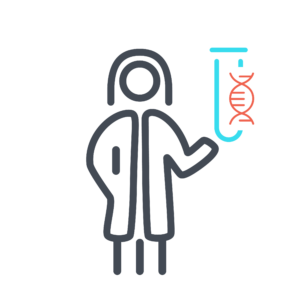PACS1-Related Syndrome

Table of contents
- What is PACS1-related syndrome?
- Key Role
- Symptoms
- What causes PACS1-related syndrome?
- Why does my child have a change in the PACS1 gene?
- What are the chances that other family members of future children will have PACS1-related syndrome?
- How many people have PACS1-related syndrome?
- Do people who have PACS1-related syndrome look different?
- How is PACS1-related syndrome treated?
- Behavior and development concerns linked to PACS2-related syndrome
- Medical and physical concerns linked to PACS2-related syndrome
- Where can I find support and resources?
- Sources and References
PACS1-related syndrome is also called Schuurs-Hoeijmakers syndrome or PACS1-related neurological disease. For this webpage, we will be using the name PACS1-related syndrome to encompass the wide range of variants observed in the people identified.
What is PACS1-related syndrome?
PACS1-related syndrome happens when there are changes in the PACS1 gene. These changes can keep the gene from working as it should.

Key Role
The PACS1 gene plays an important role in moving proteins to other cells where they are needed, and it is essential for development in the womb (in utero).
Symptoms
Because the PACS1 gene is important for brain activity, many people who have PACS1-related syndrome have:
- Language delay
- Intellectual disability
- Heart issues
- Feeding difficulty and constipation
- Low muscle tone
- Seizures
- Brain changes seen on magnetic resonance imaging (MRI)
- Behavior issues
- Features of autism
- Laughing episodes
- Attention deficit hyperactivity disorder (ADHD)
- Undescended testicles in males
What causes PACS1-related syndrome?
PACS1-related syndrome is a genetic condition, which means that it is caused by variants in genes. Our genes contain the instructions, or code, that tell our cells how to grow, develop, and work. Every child gets two copies of the PACS1 gene: one copy from their mother’s egg, and one copy from their father’s sperm. In most cases, parents pass on exact copies of the gene to their child. But the process of creating the egg or sperm is not perfect. A change in the genetic code can lead to physical issues, developmental issues, or both.
Sometimes a spontaneous variant happens in the sperm, egg or after fertilization. When a brand new genetic variant happens in the genetic code is called a ‘de novo’ genetic variant. The child is usually the first in the family to have the genetic variant.
De novo variants can take place in any gene. We all have some de novo variants, most of which don’t affect our health. But because PACS1 plays a key role in development, de novo variants in this gene can have a meaningful effect.
Research shows that PACS1-related syndrome is often the result of a de novo variant in PACS1. Many parents who have had their genes tested do not have the PACS1 genetic variant found in their child who has the syndrome. In some cases, PACS1-related syndrome happens because the genetic variant was passed down from a parent.
Autosomal dominant conditions
PACS1-related syndrome is an autosomal dominant genetic condition. This means that when a person has the one damaging variant in PACS1 they will likely have symptoms of PACS1-related syndrome. For someone with an autosomal dominant genetic syndrome, every time they have a child there is a 50 percent chance they pass on the same genetic variant and a 50 percent chance they do not pass on the same genetic variant.
Autosomal Dominant Genetic Syndrome
Why does my child have a change in the PACS1 gene?
No parent causes their child’s PACS1-related syndrome. We know this because no parent has any control over the gene changes that they do or do not pass on to their children. Please keep in mind that nothing a parent does before or during the pregnancy causes this to happen. The gene change takes place on its own and cannot be predicted or stopped.
What are the chances that other family members of future children will have PACS1-related syndrome?
Each family is different. A geneticist or genetic counselor can give you advice on the chance that this will happen again in your family.
The risk of having another child who has PACS1-related syndrome depends on the genes of both biological parents.
- If neither biological parent has the same genetic variant found in their child, the chance of having another child who has the syndrome is on average 1 percent. This 1 percent chance is higher than the chance of the general population. The increase in risk is due to the very unlikely chance that more of the mother’s egg cells or the father’s sperm cells carry the same genetic variant.
- If one biological parent has the same genetic variant found in their child, the chance of having another child who has the syndrome is 50 percent.
For a symptom-free brother or sister of someone who has PACS1-related syndrome, the sibling’s risk of having a child who has PACS1-related syndrome depends on the sibling’s genes and their parents’ genes.
- If neither parent has the same genetic variant causing PACS1-related syndrome, the symptom-free sibling has a nearly 0 percent chance of having a child who would inherit PACS1-related syndrome.
- If one biological parent has the same genetic variant causing PACS1-related syndrome, the symptom-free sibling has a 50 percent chance of also having the same genetic variant. If the symptom-free sibling has the same genetic variant, their chance of having a child who has the genetic variant is 50 percent.
For a person who has PACS1-related syndrome, the risk of having a child who has the syndrome is about 50 percent.

How many people have PACS1-related syndrome?
As of 2025, over 60 people with PACS1-related syndrome have been identified in medical research.

Do people who have PACS1-related syndrome look different?
People who have PACS1-related syndrome may look different. Appearance can vary and can include some but not all of these features:
- Low-set ears
- Long eyelashes
- Wide-set eyes
- Droopy eyelids
- Wide mouth
- Wide-set teeth
- Smaller than average head size
- Short height

How is PACS1-related syndrome treated?
Scientists and doctors have only just begun to study PACS1-related syndrome. At this point, there are no medicines designed to treat the syndrome. A genetic diagnosis can help people decide on the best way to track the condition and manage therapies. Doctors can refer people to specialists for:
- Physical exams and brain studies
- Genetics consults
- Development and behavior studies
- Other issues, as needed
A developmental pediatrician, neurologist, or psychologist can follow progress over time and can help:
- Suggest the right therapies. This can include physical, occupational, speech, or behavioral therapy.
- Guide individualized education plans (IEPs).
Specialists advise that therapies for PACS1-related syndrome should begin as early as possible, ideally before a child begins school.
If seizures happen, consult a neurologist. There are many types of seizures, and not all types are easy to spot. To learn more, you can refer to resources such as the Epilepsy Foundation’s website: epilepsy.com/…t-is-epilepsy/seizure-types

The information below highlights the most commonly reported medical findings that people with PACS1-related syndrome might have or develop. A 2021 publication by Tenorio-Castaño contains a breakdown of all reported features, including rare features. Details of that publication are listed in the Sources and References section of this guide.
Behavior and development concerns linked to PACS2-related syndrome
Speech and learning
Almost all people with PACS1-related syndrome had global developmental delay and/or intellectual disabilities. Most people had language development issues, many people were able to speak, and some people were non-verbal as they grow up.
- 56 out of 58 people had global developmental delay and/or intellectual disability (97 percent)
- 42 out of 55 people had speech delay (76 percent)
Behavior
People with PACS1-related syndrome had behavioral issues, such as autism spectrum disorder or aggression.
- 27 out of 49 people had behavioral issues (55 percent)
- 12 out of 56 people had autism spectrum disorder (21 percent)

Brain
People with PACS1-related syndrome had low muscle tone (hypotonia), changes seen on magnetic resonance imaging (MRI), seizures, and a smaller than average head size (microcephaly).
- 22 out of 58 people had hypotonia (38 percent)
- 13 out of 49 people had changes seen on MRI (27 percent)
- 33 out of 58 people had seizures (57 percent)
- 13 out of 61 people had microcephaly (21 percent)

Medical and physical concerns linked to PACS2-related syndrome
Growth and development
Some people with PACS1-related syndrome were overgrown at birth; had short height or low weight; had defects of the skeleton, kidneys, or heart; and had eye and vision issues. Heart defects included a hole in the heart, also known as an atrial or ventral septal defect.
- 4 out of 59 people had kidney defects (7 percent)
- 7 out of 54 people had heart defects (13 percent)
- 12 out of 61 people had eye findings (20 percent)
Gastrointestinal
People with PACS1-related syndrome had gastrointestinal issues, mainly constipation and gastroesophageal reflux disease (GERD). About 1 in 5 people needed a gastrostomy tube for feeding.
- 15 out of 57 people had constipation (26 percent)
- 9 out of 55 people had GERD (16 percent)
- 5 out of 61 people had a gastrostomy tube for feeding (8 percent)

Where can I find support and resources?
PACS1 Foundation
Funding scientific research to find treatments for PACS1 Syndrome
Simons Searchlight
Simons Searchlight is an online international research program, building an ever growing natural history database, biorepository, and resource network of over 175 rare genetic neurodevelopmental disorders. By joining their community and sharing your experiences, you contribute to a growing database used by scientists worldwide to advance the understanding of your genetic condition. Through online surveys and optional blood sample collection, they gather valuable information to improve lives and drive scientific progress. Families like yours are the key to making meaningful progress. To register for Simons Searchlight, go to the Simons Searchlight website at www.simonssearchlight.org and click “Join Us.”
- Learn more about Simons Searchlight: www.simonssearchlight.org/frequently-asked-questions
- Simons Searchlight webpage with more information on PACS1: www.simonssearchlight.org/research/what-we-study/pacs1
- Simons Searchlight Facebook group: https://www.facebook.com/groups/pacs1

Sources and References
The content in this guide comes from published studies about PACS1-related syndrome. Below you can find details about each study.
- Lusk, L., Smith, S., Martin, C., Taylor, C., & Chung, W. PACS1 neurodevelopmental disorder. 2020 Jul 16. In: Adam MP, Feldman J, Mirzaa GM, et al., editors. GeneReviews® [Internet]. Seattle (WA): University of Washington, Seattle; 1993-2025. Available from: https://www.ncbi.nlm.nih.gov/books/NBK559434/
- Seto, M. T., Bertoli-Avella, A. M., Cheung, K. W., Chan, K. Y., Yeung, K. S., Fung, J. L., Beetz, C., Bauer, P., Luk, H. M., … & Kan, A. S. (2021). Prenatal and postnatal diagnosis of Schuurs-Hoeijmakers syndrome: Case series and review of the literature. American Journal of Medical Genetics Part A, 185(2), 384-389. https://pubmed.ncbi.nlm.nih.gov/33166031/
- Tenorio-Castaño, J., Morte, B., Nevado, J., Martinez-Glez, V., Santos-Simarro, F., García-Miñaúr, S., Palomares-Bralo, M., Pacio-Míguez, M., Gómez, B., … & Lapunzina, P. (2021). Schuurs-Hoeijmakers syndrome (PACS1 neurodevelopmental disorder): Seven novel patients and a review. Genes (Basel), 12(5), 738. https://pmc.ncbi.nlm.nih.gov/articles/PMC8153584/
- Van Nuland, A., Reddy, T., Quassem, F., Vassalli, J. D., & Berg, A. T. (2021). PACS1-neurodevelopmental disorder: Clinical features and trial readiness. Orphanet Journal of Rare Diseases, 16(1), 386. https://pmc.ncbi.nlm.nih.gov/articles/PMC8438988/
